Stop the itching – What you need to know about allergies in dogs
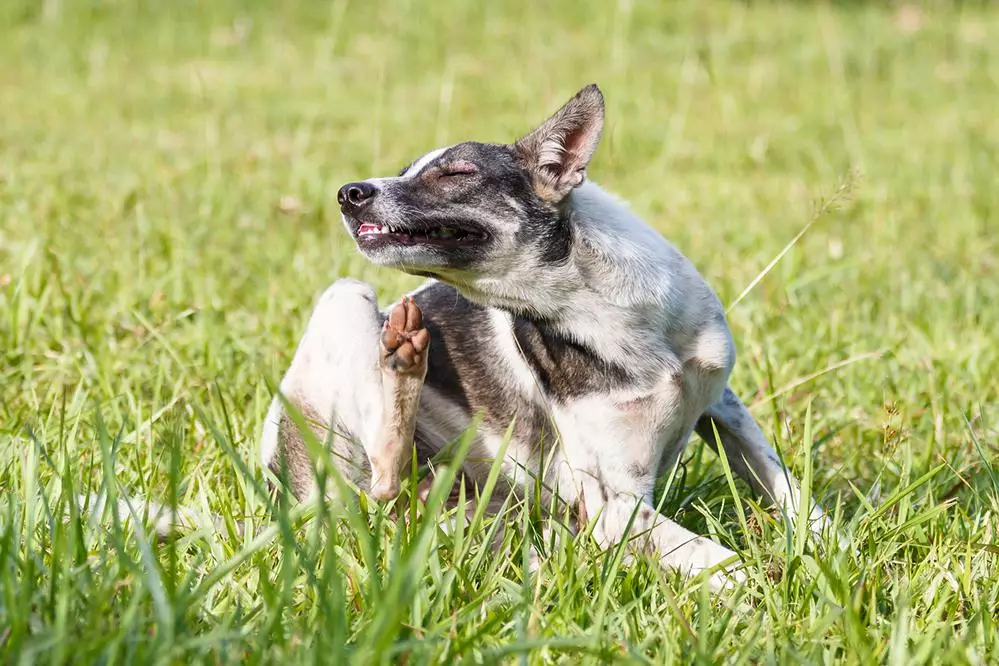
Does your dog seem overly itchy and scratchy? Chances are your dog is suffering from an allergy.
It has been estimated that nearly 20% of dogs suffer from allergies, and the numbers are increasing. In fact, allergies in dogs are almost as common as they are in people.
As they are for humans, allergies for dogs are itchy, irritating, uncomfortable, annoying and sometimes very painful. On top of this, all the dog’s scratching and licking of the itchy skin can cause secondary infections which result in increased itching, irritation, pain and discomfort.
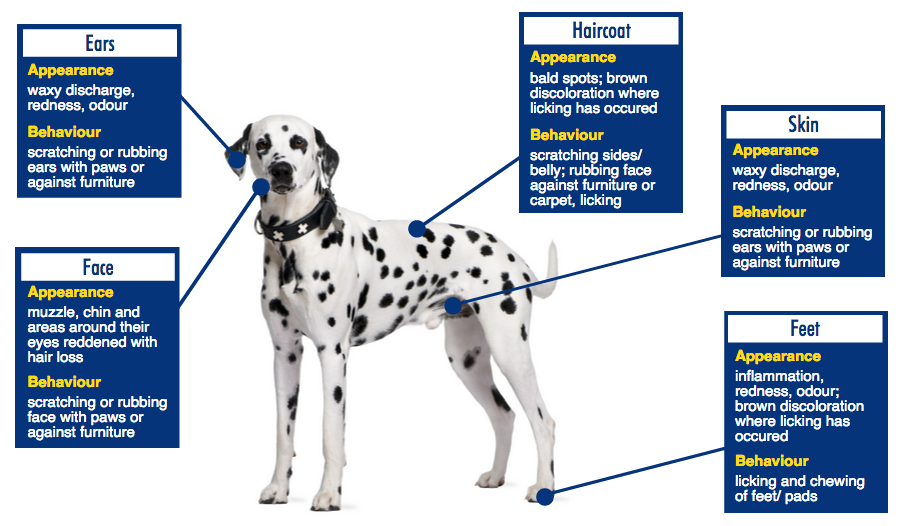
Common allergy symptoms
An allergic reaction is the result of more than one exposure to an allergenic substance. White blood cells in the body build up a memory of the allergen. The more contact the animal makes with the allergen, the more the body releases histamines (chemical compounds involved in immune responses) and the itchier the animal will be.
Allergies in dogs generally can’t be cured but can be managed.
This article explains the different types of allergies in dogs, their symptoms and how they can be treated. We also discuss how allergies are diagnosed and the dog breeds that more prone to skin conditions.
Cost of skin allergy treatment for dogs
Skin allergies were the most common health issue experienced by dogs 2022, according to PetSure claims data.
Claims data for skin allergies |
Average cost of treatment |
Highest cost of treatment |
| Dogs | $520 | $17,460 |
Because it is difficult to predict the costs of veterinary care, it can help to have measures in place to help prepare for the unexpected. Pet insurance can help by covering a portion of the eligible vet bill if the unexpected does happen.
Get a quote for 2 months free pet insurance for your puppy or kitten in their first year.
There are three main types of allergies in dogs:
Atopic allergies / atopic dermatitis
What is it?
 Atopic dermatitis is an allergic reaction to certain substances in the environment, including pollen, moulds, dust mites and even animal dander (skin or hair fragments). It is somewhat similar to hay fever in humans.
Atopic dermatitis is an allergic reaction to certain substances in the environment, including pollen, moulds, dust mites and even animal dander (skin or hair fragments). It is somewhat similar to hay fever in humans.
Dogs can come into contact with the environmental substance through either inhalation (via the mouth or nose) or direct contact (via the skin). In most cases of atopic dermatitis, the microscopic allergens penetrate directly through the skin.
Atopic allergies can occur seasonally or all year around depending on the presence of the allergen. Whenever there is a higher concentration of the substance in the animal’s environment, e.g. pollen in the air, the body releases excess histamine which then prompts symptoms such as itchiness.
Some atopic allergies may start out as seasonal, but because they are progressive (meaning that they get worse), your dog can become itchy year-round. Dust mite allergies are very common, in which case the symptoms persist even through the winter months.

6 common contact allergens (Source: Petarmor)
What are the symptoms?
Atopic allergies typically result in itchy skin and therefore the most common signs are scratching and chewing of the armpits, between the hind legs and abdomen, the face and the ears. Affected dogs will often lick, or even chew, their feet.
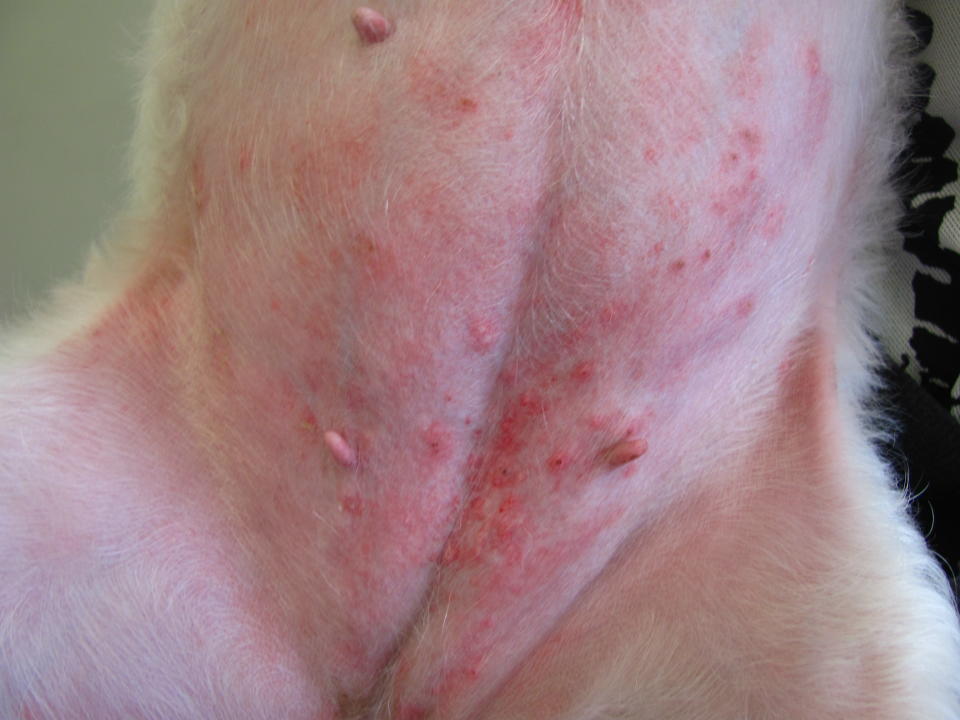
Atopic dermatitis – abdomen (Source: County Vets)

Severe, chronic case of atopic dermatitis (Source: County Vets)
You will observe redness in the affected areas, and the dog’s continual licking and scratching at the site only makes it further inflamed. This can lead to bacterial infections on the skin and the ears. Check your dog’s ears by pulling back the ear flap and looking for redness and discharge.
Typically these symptoms start between 1 and 3 years of age, however onset can occur from as early as 4 months to as late as 7 years of age.
Some of the common allergenic plants are Wandering Jew, Ragweed, Sorrel, Dock, Clover, Kikuyu, Papsalum, Fescue, Privet, Pine Oak, Birch and Couch grass.
The only way to tell which of these your dog is allergic to is to perform allergy testing at the vet.
How can Atopic Dermatits be treated?
Like many allergies, Atopic Dermatitis is a life-long condition that can’t be cured, however it can be managed in a few different ways:
- Anti-itch medications include anti-histamines, corticosteroids, antibiotics (to treat bacterial infections), medicated shampoos, conditioners and skin lotions or creams. Before using medication, always consult your vet for advice on what to use and how to use it, and be mindful of any potential side effects.
- While this isn’t often possible when it comes to environmental allergens, try to remove the source of the allergy as much as you can. Unfortunately, pollens can be carried up to 80km in the air, and dust mites are everywhere. If you can’t avoid the allergen, wipe or wash your dog’s paws to manually to remove allergens after walks and hikes. In addition to this, you can remove the allergenic weeds from your backyard.
- If the symptoms are mild and/or very occasional, you can prevent your dog from scratching by using an Elizabethan collar, socks or t-shirt to reduce the risk of infection.
- Hyposensitation therapy (allergy “vaccine” shots) is the administration of a series of injections by which your dog will gradually become desensitised to the targeted allergens. The effectiveness of this treatment can vary; however, in 75% of pets some relief has been recognised.
- Supplements such as biotin and omega-3 oils have a natural anti-inflammatory effect and may suppress itching and support coat health.
Flea Allergy Dermatitis
What it is?
Flea allergy dermatitis (FAD) is also called “flea bite hypersensitivity”, and is an allergic reaction to flea saliva. Not many fleas are needed to cause a dog to experience intense itching. It is the most common allergic reaction in dogs, with about 50% of dogs suffer from FAD.
In rare cases, dogs have been found to be allergic to other insects such as mosquitos and midges.

What are the symptoms?
Dogs that are allergic to fleas will chew and bite their backs, back legs, bellies or tails – sometimes even until it bleeds! The skin often becomes red, raw and painful and you may even see little flecks of flea dirt (which is flea poo). Flea bites often lead to hot spots – red, inflamed and/or infected lesions on the skin – due to the trauma from dogs chewing themselves in trying relieve their intense itching.
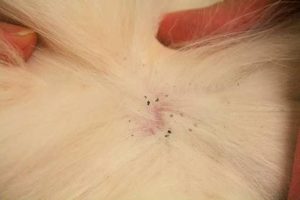 |
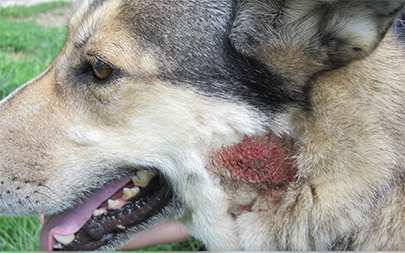 |
| Flea dirt or poo (source: https://designerdoginfo.wordpress.com/2012/11/21/controlling-and-treating-fleas-on-your-dog-part-2/) | Dog with so called “Hot Spot” caused by skin trauma from excessive scratching and licking (Source: Rover.com) |
 |
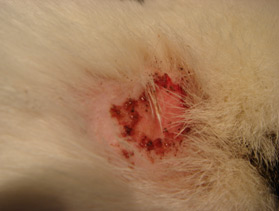 |
| Flea bites (Source: West Coast Vets NZ) | Flea bites (Source: West Coast Vets NZ) |
How can it be treated?
The most effective method is to be very diligent and use products to kill and prevent fleas from infesting your dog. As fleas are pretty much everywhere, it is almost impossible for your dog not to have fleas unless you are using a good-quality flea control product all year around.
There are many efficient and convenient products available, but it’s always advisable to ask your vet for advice. Your vet may prescribe steroids and antihistamines to break the cycle of itching and scratching. Regular warm baths with medicated anti-itch shampoo and conditioner can also help.
You should also vacuum regularly and wash your pet’s bedding frequently in hot water (>60 degrees celsius).
 Be aware of possible flea exposures if you have other dogs visiting (especially if you don’t know whether they are on flea control or not) or if your dog visits places where there are other dogs, such as dog boarding, doggy daycare and dog parks.
Be aware of possible flea exposures if you have other dogs visiting (especially if you don’t know whether they are on flea control or not) or if your dog visits places where there are other dogs, such as dog boarding, doggy daycare and dog parks.
Flea prevention all year round is really important, and even more so if your dog has FAD. Once you have a flea infestation on your dog and in your home, it becomes a nightmare and is very difficult to resolve. Make sure all other pets in the household are also treated.
Using a flea comb may help to find out if your dog has fleas, however, fleas are tricky to find as they are good at hiding and running away to escaping the comb. Also, only 5% of fleas actually live on the dog; the remaining 95% ( including the eggs, larvae and pupae) live in the environment (e.g. bedding, parks, carpets, gaps in floorboards and garden).
Click here to learn more more about how to control fleas.
A pet insurance policy with Bow Wow Meow will help ensure you can always afford to give your pet the best treatment.
- Find out more about our pet insurance options for dogs
Food Allergies
What is it?
Food allergy occurs when your dog is allergic to one or more foods. The most common allergen foods for dogs are:
- Beef
- Milk
- Chicken
- Eggs
- Fish
- Cereals (wheat, soya, corn)
It is not clear what causes a food allergy. It is surmised that changes in the animal’s immune system cause the body to see certain ingredients as ‘foreign’, which leads to an immune response that causes the allergic reaction. Fortunately, food allergy in dogs is relatively uncommon.

Dog with Hair loss secondary to food allergy (Source: Zoetis U.S.)
What are the symptoms?
The main symptom is itching of the skin that results in licking and chewing, especially around the face, paws and ears.
This can be accompanied by an unpleasant skin odour, excessive scaling, red bumps, pimples and ear and skin infections. In some cases, gastrointestinal symptoms occur, such as indigestion, noisy gut sounds, intermittent mild diarrhoea and vomiting.
Diagnosis of a food allergy is a lengthy process which involves working very closely with your vet for months using a system of diet trials.
Diagnosis is a long process which involves working very closely with your vet for months using a system of diet trials.
Once you know exactly what your dog is allergic to, then it can be managed more easily.
How can it be treated?
Once you know what your dog is allergic to, you can manage your dog’s diet in order to prevent flare-ups (a flare-up is when the skin becomes worse and intense treatment is required). In some cases, the vet may prescribe medication such as antihistamines and steroids.
How are allergies diagnosed?
If you are visiting your vet more than 3 times per year for itching, ear or skin infection, ask your vet about possible dog allergies. Allergies cannot be cured, but with patience and diligence, they can be managed successfully .
Keeping a detailed history of your dog’s itching will be helpful for the diagnosis. This means monitoring and recording the symptoms in detail: what you observed, when it occurred, what happened before, any treatment given and the outcome.
The symptoms of different dog allergies are usually very similar, which can make it hard to tell which is the underlying cause. It is best is to consult your family vet before jumping to any conclusions.
Your vet will suspect an allergy based on the dog’s symptoms but will first rule out common and curable causes of itching such as fleas, mites, bacteria and yeast infections. Find out more about other skin conditions in dogs.
- Testing for atopic allergies is done through skin or serum (blood) testing in a similar way it is done for people.
- For flea allergies, vets will look for a typical pattern of skin inflammation as well as the presence of fleas and/or flea dirt, scratching and skin sores. Often they will prescribe a specific flea treatment trial to determine whether fleas are the problem.
- To identify a food allergy, the dog will need to be put on an exclusion diet for 8-12 weeks. This means the animal is fed only ingredients that he has never eaten before; he cannot eat anything else at all for that time. As food allergies are uncommon in dogs, we advise work with your vet to make sure there is not another underlying cause that can more easily be managed.
Recommended products that can help
Regardless of the type of allergy your dog is suffering from, it is very important to reduce the symptoms as much as possible. Anti-itch medication may be prescribed by your vet but if not, there are other helpful products available over-the-counter at pet retail stores and veterinary clinics. Products such as gentle medicated shampoos, conditioners, skin lotions or creams and fish and linseed oils can help to reduce skin irritations, prevent secondary infections and assist with healing your dog’s skin.
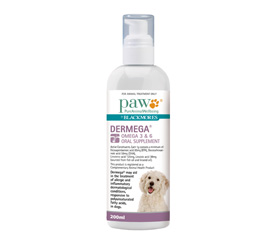 |
PAW Dermega® Omega 3 & 6 Oral SupplementThis product is specifically designed for skin health. Containing omega fatty acids, it may aid in the treatment of allergic and inflammatory skin conditions in dogs. |
 |
PAW MediDerm Gentle Medicated ShampooThis shampoo is an effective low-irritant, antibacterial and antifungal shampoo that is gentle on the skin. |
 |
PAW NutriDerm® Replenishing ConditionerAn innovative and advanced conditioner to moisturise and provide key nutrients to your dog’s skin. This product is suitable for dogs and cats with normal, dry and itchy skin. |
 |
Dermoscent® Essential 6® spot on for DogsA blend of essential fatty acids & essential oils that reduces odour, moisturises dry skin and maintains coat and skin health. Applied directly to the skin and easy for pet owners to use without having to bathe their pets. |
Are all dogs prone to allergies?
Generally, every dog is at risk of an allergic reaction to a substance. Some breeds however are more susceptible than others due of genetics, making their skin more fragile and sensitive to allergens.
Here are some of the breeds that are more prone to skin allergies:
- West Highland White Terrier
- Irish Setter
- Shar-Pei
- Maltese
- Bulldog
- Spaniel
- Dalmatian
- Labrador
- Golden Retriever
- Staffordshire Bull Terrier
If your dog suffers from an allergy, we recommend that you do not breed the dog, as an allergy is often an inherited condition.
Bottom Line
Allergies in dogs are more common than most of us think, and the number of allergic dogs is increasing. There are many different substances that can cause an allergic reaction in our dogs. Whilst you can’t cure dog allergies, you can manage them so your dog can live a comfortable, almost itch-free life again.
You will need to consult your vet to identify the type of allergy your pet is suffering from so as to find the best treatment suited to your dog.
A pet insurance policy with Bow Wow Meow will help ensure you can always afford to give your pet the best treatment.
- Find out more about our pet insurance options for dogs








